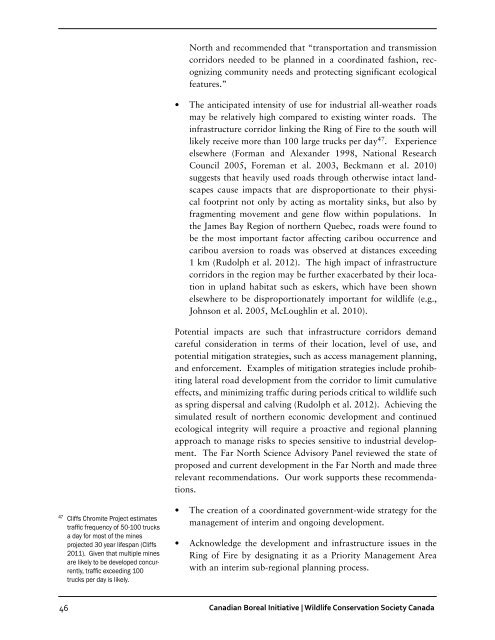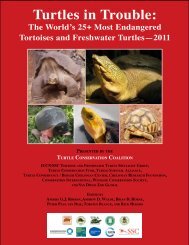You also want an ePaper? Increase the reach of your titles
YUMPU automatically turns print PDFs into web optimized ePapers that Google loves.
North and recommended that “transportation and transmission<br />
corridors needed to be planned in a coordinated fashion, recognizing<br />
community needs and protecting significant ecological<br />
features.”<br />
• The anticipated intensity of use for industrial all-weather roads<br />
may be relatively high compared to existing winter roads. The<br />
infrastructure corridor linking the Ring of Fire to the south will<br />
likely receive more than 100 large trucks per day 47 . Experience<br />
elsewhere (Forman and Alexander 1998, National Research<br />
Council 2005, Foreman et al. 2003, Beckmann et al. 2010)<br />
suggests that heavily used roads through otherwise intact landscapes<br />
cause impacts that are disproportionate to their physical<br />
footprint not only by acting as mortality sinks, but also by<br />
fragmenting movement and gene flow within populations. In<br />
the James Bay Region of northern Quebec, roads were found to<br />
be the most important factor affecting caribou occurrence and<br />
caribou aversion to roads was observed at distances exceeding<br />
1 km (Rudolph et al. 2012). The high impact of infrastructure<br />
corridors in the region may be further exacerbated by their location<br />
in upland habitat such as eskers, which have been shown<br />
elsewhere to be disproportionately important for wildlife (e.g.,<br />
Johnson et al. 2005, McLoughlin et al. 2010).<br />
Potential impacts are such that infrastructure corridors demand<br />
careful consideration in terms of their location, level of use, and<br />
potential mitigation strategies, such as access management planning,<br />
and enforcement. Examples of mitigation strategies include prohibiting<br />
lateral road development from the corridor to limit cumulative<br />
effects, and minimizing traffic during periods critical to wildlife such<br />
as spring dispersal and calving (Rudolph et al. 2012). Achieving the<br />
simulated result of northern economic development and continued<br />
ecological integrity will require a proactive and regional planning<br />
approach to manage risks to species sensitive to industrial development.<br />
The Far North Science Advisory Panel reviewed the state of<br />
proposed and current development in the Far North and made three<br />
relevant recommendations. Our work supports these recommendations.<br />
47<br />
Cliffs Chromite Project estimates<br />
traffic frequency of 50-100 trucks<br />
a day for most of the mines<br />
projected 30 year lifespan (Cliffs<br />
2011). Given that multiple mines<br />
are likely to be developed concurrently,<br />
traffic exceeding 100<br />
trucks per day is likely.<br />
• The creation of a coordinated government-wide strategy for the<br />
management of interim and ongoing development.<br />
• Acknowledge the development and infrastructure issues in the<br />
Ring of Fire by designating it as a Priority Management Area<br />
with an interim sub-regional planning process.<br />
46 Canadian Boreal Initiative | Wildlife Conservation Society <strong>Canada</strong>







![RaLand / SeaScape [PDF] - Wildlife Conservation Society](https://img.yumpu.com/49974326/1/190x245/raland-seascape-pdf-wildlife-conservation-society.jpg?quality=85)









